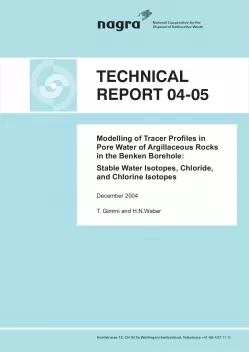
Technical Report NTB 04-05
Modelling of Tracer Profiles in Pore Water of Argillaceous Rocks in the Benken Borehole: Stable Water Isotopes, Chloride and Chlorine Isotopes
Isotope tracers offer unique possibilities for analysing flow and transport processes over large scales of time and space. This is especially relevant for low-permeability media like claystones, where transport is typically very slow and, consequently, difficult to investigate. Such lithologies are currently being investigated in several countries as potential host rocks for the disposal of radioactive or other hazardous waste. In the deep borehole at Benken (north-eastern Switzerland), a sequence of aquifers and argillaceous aquitards was investigated. Water samples were obtained from four formations (Malm, Keuper, Muschelkalk, and Buntsandstein). The Malm and the Keuper aquifer delimit a sequence of claystones and marls at depth from about 400 to 700 m with hydraulic conductivities generally below 10–13 m s–1. Profiles of δ18O, δ2H, chloride, and δ37Cl in pore fluids of these formations were obtained. The chemical, isotopic, and noble gas composition of the ground water samples indicated that no cross-formation flow occurred, but that – with the exception of the Malm – the waters evolved geochemically within the formation from which they were sampled. Infiltration conditions could also be inferred from the data. The pore water profiles in the low-permeability zone show clear trends that hint at diffusion-dominated transport processes. To evaluate possible mechanisms and time scales of evolution of the profiles, a series of advective-dispersive model calculations was performed. Varying initial conditions as well as the type and concentration values of boundary conditions revealed the following: (i), molecular diffusion to the underlying aquifer can explain the general features of the isotope profiles, (ii), no signatures of advective flow could be detected, (iii), the evolution time is in the order of 0.5 to 1 Ma (relying on laboratory diffusion coefficients) with a possible range of about 0.2 to 2 Ma, which is geologically plausible, and, (iv), parameters measured on small scales (centimeters or meters, months) are also plausible at the formation scale (tens of meters, millions of years) for the sediments investigated.
